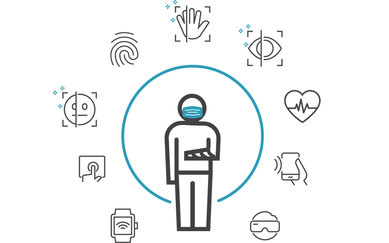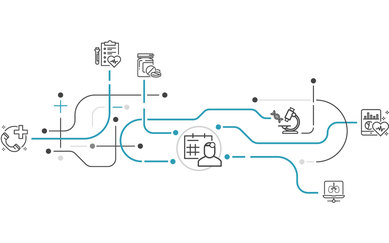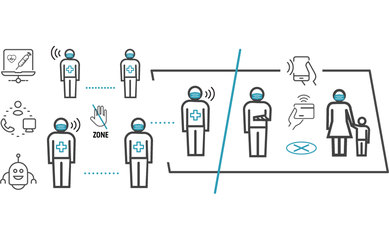Learning from COVID-19: Now is the Time to Rethink Healthcare Delivery

As we prepare for recovery from the COVID-19 crisis, SmithGroup is formulating solutions to address the infection control concerns that patients and staff are bound to have as we return to "normal." But will the healthcare setting return to normal, or reset to something new?
We have had a tremendous shock to the healthcare system. There will, rightly, be hundreds of papers and studies looking at the issues of capacity, access and equity, public health, and our entire system of care. But the foremost need is a proactive and immediate response to infection control concerns that will be required to encourage patients to return to healthcare settings after the pandemic subsides.
The return of patients will be critical in helping healthcare institutions manage through the current financial challenges that have been created by this crisis, including a precipitous drop in revenue, investment losses, and depleted cash reserves. There is also growing concern that patients will continue to forego or delay the care they need due to fear of infection, which could have long-term effects on patient outcomes.
Hospitals and care facilities of all types will need to demonstrate a clear, visible response to patient and staff safety to mitigate these fears. The SmithGroup healthcare team is exploring several new safety concepts and their impact on the facility environment. These ideas are envisioned to work together to create a new, holistic model of care that enhances patient access, limits potential infection, and focuses on getting the healthcare system back on track while keeping patients and staff safe.

TECHNOLOGY
"Stay at home" has become a new mantra for healthcare. Out of necessity, providers and patients have embraced telehealth for stay-at-home care as never before, as barriers to adoption and reimbursement challenges have been eliminated. This short-term solution to manage during the COVID-19 crisis is also a long-term solution for improved patient access and reduced infection transmission. To effectively integrate telemedicine into the care model, a more strategic approach to planning and design will be needed to right-size facilities and limit overbuilding.
Exploring Proactive Valet Health
- Self-monitoring wearables
- Virtual tele-consults/visits
- Virtual care coordinator to identify the safest path to care
- Home consult, delivery of medicines, monitoring devices, rehabilitation
- Centralized care coordination resources (same protocols, virtual proactive contact, healthcare valet)

PROCESS
Technology, process and facilities must work together. No-touch patient facility solutions will become standard practice. The touchless concept necessitates environments and processes that will reduce or eliminate the need for patients and staff to physically contact furniture, fixtures, and devices. New patient pathways will be defined to limit patient and visitor gathering and support a streamlined, continuous forward movement through the healthcare process, reducing the opportunity for cross-traffic and potential contamination. Staff safety zones will create caregiver environments that are enhanced with improved air quality solutions and reduced risk of contagions.
Robotics can be used for no-touch dispensing, delivery and transfers as well as cleaning and maintenance. Technology practices for scheduling and registration will enable patients to complete paperwork from home via online portals or apps, eliminating the need for patients and staff to touch potentially contaminated clipboards, pens, and electronic devices at each medical visit.
Exploring the Patient Pathfinder
- AI-enabled apps for entering symptoms and determining the ideal patient pathway
- Direct patient to caregiver with first available appointment (patient navigator)
- Direct patient to safest facility entry/path to service: limit going through long corridors and areas of possible contamination, strip mall portal concepts with clean corridors
- Facility ratings for infection control management
Improving operational processes, like patient intake, can also help prevent infection spread. Enabling patients who require a face-to-face visit to self-room will eliminate time in the waiting room and the risk of infection through contaminated furniture and fixtures.
Exploring Tele-Check-In
- No-touch registration, with tele-sign and proactive administrative updates
- Self-rooming with arrival detection through digital dashboards
- Wearable download devices to transfer monitoring and diagnostic data directly to the patient electronic health record

PEOPLE
Creating safe staff zones is imperative to reduce the risk of infection for our caregivers. The current on-stage/off-stage concept for facility design is a start, but clean core working environments go a step further. This concept provides designated, no-patient-access staff areas (off-stage) that are supported by enhanced mechanical systems to provide a cleaner and safer environment. This will become especially critical as providers call on retired or physically-compromised staff to address acute staff shortages.
Exploring Staff Safety Zones
- Off-stage safe hub for home and telehealth monitoring sites (virtual care centers)
- Mechanically enhanced staff safe zones in healthcare facilities (humidity control, air treatment systems, additional outside air)
- Defined facility zoning to limit traffic and to provide for zoned isolation as needed
PLACE
Facility design can support the no-touch concept by providing sensor controls for doors, lights and other devices, eliminating the need for staff and patients to potentially cross contaminate via the built environment.
Exploring the No-Touch Facility Environment
- No-touch patient path to exam: no waiting, self-rooming, automatic doors
- Coordinated off-stage areas for staff: target zero touch between patient visits, automatic doors, voice-controlled documentation or tele-scribes
- 100% automatic water sensors (touchless sinks) with effective timing mechanisms for infection control; motion- or voice-activated controls (temperature, lighting)
The time to plan and design for recovery is now; if we wait until the COVID-19 crisis is over it will be too late to ensure that facilities and operations can be adapted in time to welcome patients back—and give patients, and staff, the confidence that they will be safe from infection. The SmithGroup team is working to create a future facility planning and design strategy that is realistic, holistic, and proactive: a carefully designed integration of technology, process, people and place that will allow us to create a new healthcare "normal."
Never before has the healthcare industry had this singular opportunity to rethink how healthcare is provided. With the shutdown of most healthcare portals, now is the time to redefine how to reopen and enact meaningful change. Do we go back to business as normal, or proactively seize this opportunity to discuss how to rebuild healthcare to embrace the next generation of healthcare challenges?